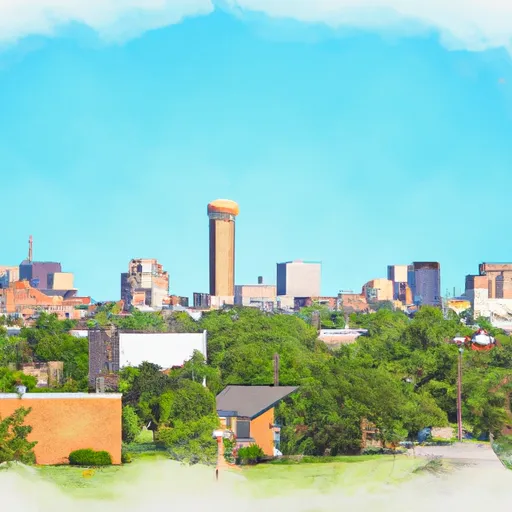-
 Snoflo Premium
Snoflo Premium
Get unlimited access to all our content
With no Ad interruptions! - Start Your Free Trial Login with existing account
Union-City
Eden Index
Climate
8.3
•
Recreation
2.5
•
Community
2.1
•
Safeguard
4.7/10

Union City, Oklahoma is a charming town located in Canadian County, in the central part of the state. The climate in Union City is classified as humid subtropical, with hot summers and mild winters. Summers are characterized by high temperatures, averaging in the mid-90s Fahrenheit, while winters see temperatures hovering around the mid-40s.
The hydrology constituents in Union City primarily revolve around the Canadian River, which flows just south of the town. The river presents excellent opportunities for fishing, boating, and other water-based activities. Additionally, the area is dotted with numerous lakes and reservoirs, such as Lake El Reno and Lake Overholser, providing further recreational opportunities for swimming, kayaking, and picnicking.
Outdoor enthusiasts in Union City can also explore the surrounding countryside, which offers beautiful landscapes and ample hiking and biking trails. The nearby Red Rock Canyon State Park is a popular destination for rock climbing, rappelling, and camping. The town is surrounded by picturesque scenery, making it an ideal location for nature lovers and those seeking outdoor adventure.
What is the Eden Index?
The Snoflo Eden Index serves as a comprehensive rating system for regions, evaluating their desirability through a holistic assessment of climate health, outdoor recreation opportunities, and natural disaster risk, acknowledging the profound impact of these factors on livability and well-being.
Climate Health Indicator (CHI): 8.3
Union-City receives approximately
903mm of rain per year,
with humidity levels near 80%
and air temperatures averaging around
16°C.
Union-City has a plant hardyness factor of
7, meaning
plants and agriculture in this region tend to thrive during the non-winter months.
By considering the ideal temperature range, reliable water supplies, clean air, and stable seasonal rain or snowpacks, the Climate Health Indicator (CHI) underscores the significance of a healthy climate as the foundation for quality living.
A healthy climate is paramount for ensuring a high quality of life and livability in a region, fostering both physical well-being and environmental harmony. This can be characterized by ideal temperatures, reliable access to water supplies, clean air, and consistent seasonal rain or snowpacks.
Weather Forecast
Streamflow Conditions
Lower Canadian
Area Rivers
Lower Canadian
Snowpack Depths
Lower Canadian
Reservoir Storage Capacity
Lower Canadian
Groundwater Levels
Recreational Opportunity Index (ROI): 2.5
The Recreational Opportunity Index (ROI) recognizes the value of outdoor recreational options, such as parks, hiking trails, camping sites, and fishing spots, while acknowledging that climate plays a pivotal role in ensuring the comfort and consistency of these experiences.
Access to outdoor recreational opportunities, encompassing activities such as parks, hiking, camping, and fishing, is crucial for overall well-being, and the climate plays a pivotal role in enabling and enhancing these experiences, ensuring that individuals can engage in nature-based activities comfortably and consistently.
Camping Areas
| Campground | Campsites | Reservations | Toilets | Showers | Elevation |
|---|---|---|---|---|---|
| Lake Chickasha | 50 | 1,207 ft | |||
| Clear Creek Lake | None | 1,181 ft | |||
| Chisolm Trail Ridge - Waurika Lake | None | 975 ft | |||
| Wichita Ridge - Waurika Lake | None | 1,001 ft | |||
| Kiowa Park - Waurika Lake | None | 979 ft | |||
| Moneka Park - Waurika Lake | None | 906 ft | |||
| Schrock Park | None | 1,305 ft | |||
| Taylor Lake | 20 | 1,289 ft |
Nearby Ski Areas
Catastrophe Safeguard Index (CSI):
The Catastrophe Safeguard Index (CSI) recognizes that natural disaster risk, encompassing floods, fires, hurricanes, and tornadoes, can drastically affect safety and the overall appeal of an area.
The level of natural disaster risk in a region significantly affects safety and the overall livability, with climate change amplifying these risks by potentially increasing the frequency and intensity of events like floods, fires, hurricanes, and tornadoes, thereby posing substantial challenges to community resilience and well-being.
Community Resilience Indicator (CRI): 2.1
The Community Resilience Indicator (CRI) recognizes that education, healthcare, and socioeconomics are crucial to the well-being of a region. The CRI acknowledges the profound impact of these elements on residents' overall quality of life. By evaluating educational resources, healthcare accessibility, and economic inclusivity, the index captures the essential aspects that contribute to a thriving community, fostering resident satisfaction, equity, and social cohesion.

